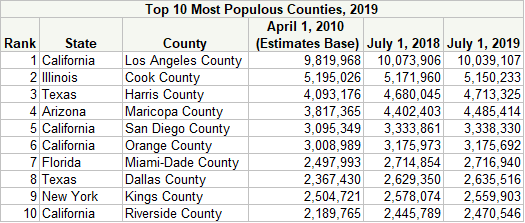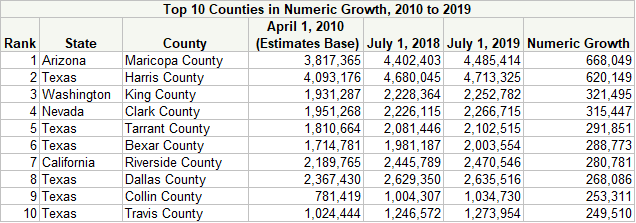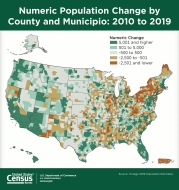For Immediate Release: Thursday, March 26, 2020
Most of the Counties with the Largest Population Gains Since 2010 are in Texas
Over half of U.S. Counties were smaller in 2019 than they were in 2010
Phoenix breaks into the top 10 largest metro areas, as Boston drops out of the top 10
MARCH 26, 2020 — Six of the 10 counties with the largest population gains this decade were in Texas — Harris, Tarrant, Bexar, Dallas, Collin, and Travis — according to the U.S. Census Bureau’s July 1, 2019, population estimates released today. The statistics provide population estimates and components of change for the nation’s 384 metropolitan statistical areas, 542 micropolitan statistical areas and 3,142 counties.
Among the nation’s counties, the top 10 with the largest numeric gains since 2010 are all located in the South and the West. In addition to the six Texas counties, the remaining four counties on the list are Maricopa County, Arizona; King County, Washington; Clark County, Nevada; and Riverside County, California. Texas counties also occupied the most spots of any state in the top 10 fastest growing since 2010, where Hays, Comal, Kendall, and Williamson all made the list.
Despite the growth in some counties, over half (53.6%) of the counties in the United States were smaller in 2019 than they were in 2010. These patterns of growth or decline were largely related to county size, with most small counties losing population this decade and most large counties gaining.
“One interesting trend we have seen this decade is widespread population decline among smaller counties, while larger counties tended to have population growth,” said Dr. Christine Hartley, a demographer in the Census Bureau’s Population Division. “Three out of four counties with a population of less than 10,000 in 2010 had even smaller populations in 2019. At the same time, three out of four counties of 50,000 or more were larger in 2019 compared to 2010.” This pattern among larger counties was particularly evident in the West and South.
Among metropolitan areas, Phoenix-Mesa-Chandler, AZ, with a population of 4,948,203 in 2019, replaced Boston-Cambridge-Newton, MA-NH as the 10th most populous metropolitan area in the country (Table 4). Dallas-Fort Worth-Arlington, TX had the largest numeric gain since 2010, with an increase of 1,206,599 (19.0%) (Table 5).
Of counties with a population of 20,000 or more in 2018 and 2019, Williams County, North Dakota, was the fastest-growing county this decade, increasing by 67.8% (from 22,399 to 37,589) between 2010 and 2019 (Table 3). The rapid growth experienced by Williams County, North Dakota, between 2010 and 2019 was largely due to an 11,233 gain from net domestic migration (movement into the county from elsewhere in the United States). The county also grew between 2010 and 2019 by natural increase (3,400) and net international migration (170).
Additional Highlights:
Counties
- Growth and decline:
- Out of 3,142 counties and county equivalents, 1,610 (51.2%) gained population between 2018 and 2019. Nine counties (0.3%) experienced no change in population during this time, while the remaining 1,523 (48.5%) lost population.
- Between 2010 and 2019, 1,459 (46.4%) counties gained population, and 1,683 (53.6%) lost population.
- Natural increase:
- Of the 3,142 counties, 1,799 (57.3%) experienced natural increase between 2010 and 2019, meaning the county had more births than deaths.
- Net migration:
- Among the 3,142 counties, 1,290 (41.1%) counties showed positive net migration between 2010 and 2019, meaning more people moved into the county than moved out.
- Between 2010 and 2019, over half of counties (63.9%) experienced net domestic out migration. During the same period, only 13.9% of counties lost population through net international migration.
Municipios
- Of Puerto Rico’s 78 municipios, 45 (57.7%) saw a population increase in the last year. The largest gain (1,027) and fastest growth (2.2%) between 2018 and 2019 were in Gurabo Municipio. Additionally, Gurabo Municipio is the only municipio in Puerto Rico whose population in 2019 was larger than in 2010, increasing by 1,722 people (3.8%).
- Between 2018 and 2019, 67 (85.9%) municipios in Puerto Rico experienced natural decrease (more deaths than births). Between 2010 and 2019, 18 (23.1%) of the 78 municipios had natural decrease.
Metropolitan Areas
- Growth:Three of top ten metro areas with the largest gains in population between 2010 and 2019 were in Texas. Dallas-Fort Worth-Arlington, TX, had the largest numeric growth, with its population increasing by 1,206,599 (19.0%), followed by Houston-The Woodlands-Sugar Land, TX, increasing by 1,145,654 (19.4%), and Austin-Round Rock-Georgetown, TX, up by 510,760 (29.8%) (Table 5).
- Decline:
- Of the 384 metro areas within the United States, 91 (23.7%) experienced a decline in population between 2010 and 2019.
- The five fastest-decreasing metro areas since 2010 were Pine Bluff, AR (-12.4%); Johnstown, PA (-9.4%); Charleston, WV (-7.5%); Beckley, WV (-7.3%); and Danville, IL (-7.2%).
- All metropolitan areas in Puerto Rico were smaller in 2019 than in 2010. The largest numeric decrease was in the San Juan-Bayamón-Caguas, PR, metro area, which was 327,099 (-13.9%) smaller in 2019 than in 2010. The largest percentage decrease in population since 2010 was in the Yauco, PR, metro area, which declined by 21,407 (-20.0%).
Micropolitan Areas
- Of the 542 micropolitan areas in the United States, 243 (44.8%) gained population between 2010 and 2019.
- Over one-half (55.9%) of the micropolitan areas in the United States experienced natural increase in the last year. 352 (64.9%) micropolitan areas had natural increase between 2010 and 2019.
Vintage 2019 is the last series of population estimates to be released before the completion of the 2020 Decennial Census, which is currently underway across the nation. Data from the 2020 Census will be released beginning this December and running all through 2021. During the remainder of 2020, the Census Bureau will release estimates of the July 1, 2019 population for the nation, states and counties by age, sex, race and Hispanic origin. Population estimates for Puerto Rico and its municipios by age and sex will be released as well. These estimates include counties and cities affected by the 2017 hurricane season. Regular releases of the population estimates will resume with the Vintage 2021 estimates series.
American FactFinder (AFF) will be taken offline on March 31, 2020. Population and housing unit estimates data previously released on AFF are now available on the Population and Housing Unit Estimates website. With each new release of annual estimates, the entire time series of estimates is revised for all years back to the last census. All previously-published estimates (e.g., old vintages) are superseded and archived on the FTP2 site. Files previously released on AFF are also available on the FTP2 site. Please use the searchable index of the FTP2 site for a complete inventory of all content available on the site.
###












